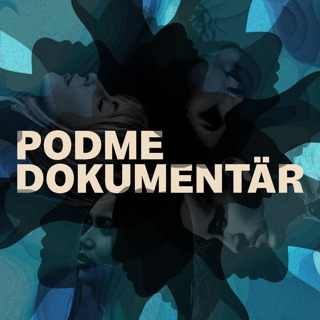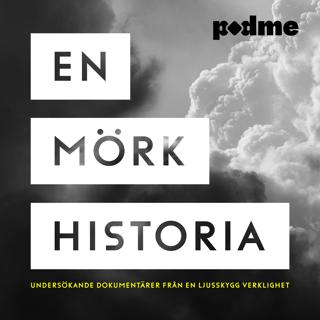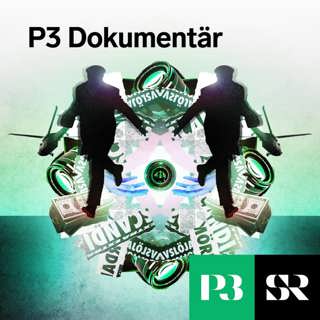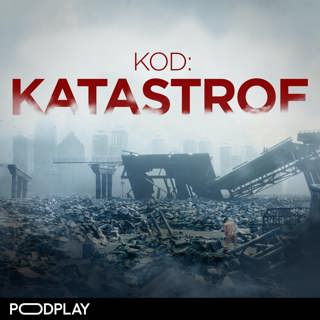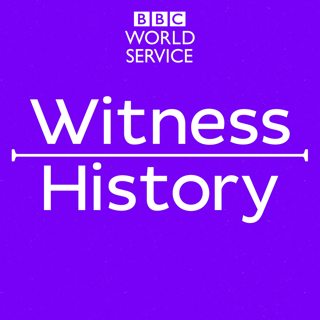
'Robocops’ in the Democratic Republic of Congo
After the death of her brother, engineer Thérèse Izay Kirongozi got to work handmaking huge robots to direct traffic and save lives. In 2013 they were installed on the streets of Kinshasa, in the Democratic Republic of Congo. They have green lights on their hands, a red light in their chest, can turn around and live stream to a police control centre, they also sing when children cross the road. You might also see the ‘female’ robots wearing skirts, make-up and hoop earrings. Thérèse speaks to Megan Jones about her invention. Eye-witness accounts brought to life by archive. Witness History is for those fascinated by the past. We take you to the events that have shaped our world through the eyes of the people who were there. For nine minutes every day, we take you back in time and all over the world, to examine wars, coups, scientific discoveries, cultural moments and much more. Recent episodes explore everything from football in Brazil, the history of the ‘Indian Titanic’ and the invention of air fryers, to Public Enemy’s Fight The Power, subway art and the political crisis in Georgia. We look at the lives of some of the most famous leaders, artists, scientists and personalities in history, including: visionary architect Antoni Gaudi and the design of the Sagrada Familia; Michael Jordan and his bespoke Nike trainers; Princess Diana at the Taj Mahal; and Görel Hanser, manager of legendary Swedish pop band Abba on the influence they’ve had on the music industry. You can learn all about fascinating and surprising stories, such as the time an Iraqi journalist hurled his shoes at the President of the United States in protest of America’s occupation of Iraq; the creation of the Hollywood commercial that changed advertising forever; and the ascent of the first Aboriginal MP.
11 Okt 202410min

How the QR code was invented
In 1994, bar codes were in widespread use in businesses around the world, but the Japanese car component company, Denso Wave, wanted something quicker.So they asked one of their engineers, Masahiro Hara, to come up with a solution.After playing his favourite board game, Go, he came back with an idea.He designed a black and white square of data that was fast, practical, and could handle more than 200 times the information contained in a barcode.It was called the Quick Response code, or QR for short. And today it’s used, in some form, by millions of us around the world every day.Masahiro Hara tells Jane Wilkinson about his pride in his invention.Eye-witness accounts brought to life by archive. Witness History is for those fascinated by the past. We take you to the events that have shaped our world through the eyes of the people who were there. For nine minutes every day, we take you back in time and all over the world, to examine wars, coups, scientific discoveries, cultural moments and much more. Recent episodes explore everything from football in Brazil, the history of the ‘Indian Titanic’ and the invention of air fryers, to Public Enemy’s Fight The Power, subway art and the political crisis in Georgia. We look at the lives of some of the most famous leaders, artists, scientists and personalities in history, including: visionary architect Antoni Gaudi and the design of the Sagrada Familia; Michael Jordan and his bespoke Nike trainers; Princess Diana at the Taj Mahal; and Görel Hanser, manager of legendary Swedish pop band Abba on the influence they’ve had on the music industry. You can learn all about fascinating and surprising stories, such as the time an Iraqi journalist hurled his shoes at the President of the United States in protest of America’s occupation of Iraq; the creation of the Hollywood commercial that changed advertising forever; and the ascent of the first Aboriginal MP.(Photo: A QR code connecting to the Witness History episode about... QR codes! Credit: BBC)
10 Okt 202410min

The world's first general purpose electronic computer
In 1946, one of the world’s first electronic computers was unveiled in Philadelphia, in the USA. It was called the Electronic Numerical Integrator and Computer, or ENIAC, and was initially designed to do calculations for ballistics trajectories. It was programmed by six female mathematicians. Rachel Naylor speaks to Gini Mauchly Calcerano, whose dad John Mauchly co-designed it, and whose mum, Kay McNulty, was one of the programmers. Eye-witness accounts brought to life by archive. Witness History is for those fascinated by the past. We take you to the events that have shaped our world through the eyes of the people who were there. For nine minutes every day, we take you back in time and all over the world, to examine wars, coups, scientific discoveries, cultural moments and much more. Recent episodes explore everything from football in Brazil, the history of the ‘Indian Titanic’ and the invention of air fryers, to Public Enemy’s Fight The Power, subway art and the political crisis in Georgia. We look at the lives of some of the most famous leaders, artists, scientists and personalities in history, including: visionary architect Antoni Gaudi and the design of the Sagrada Familia; Michael Jordan and his bespoke Nike trainers; Princess Diana at the Taj Mahal; and Görel Hanser, manager of legendary Swedish pop band Abba on the influence they’ve had on the music industry. You can learn all about fascinating and surprising stories, such as the time an Iraqi journalist hurled his shoes at the President of the United States in protest of America’s occupation of Iraq; the creation of the Hollywood commercial that changed advertising forever; and the ascent of the first Aboriginal MP.(Photo: Computer operators programming the ENIAC. Credit: Corbis via Getty Images)
9 Okt 20249min

WABOT-1: The first humanoid robot
Scientists at Waseda University in Japan built the world's first humanoid robot in 1973. They called it the 'WABOT', the Waseda robot. It could see, walk and even talk. It was a huge leap forward in the history of artificial intelligence and robotics. Dr Hiromichi Fujisawa tells Ben Henderson how he was tasked with making the robot speak.Eye-witness accounts brought to life by archive. Witness History is for those fascinated by the past. We take you to the events that have shaped our world through the eyes of the people who were there. For nine minutes every day, we take you back in time and all over the world, to examine wars, coups, scientific discoveries, cultural moments and much more. Recent episodes explore everything from football in Brazil, the history of the ‘Indian Titanic’ and the invention of air fryers, to Public Enemy’s Fight The Power, subway art and the political crisis in Georgia. We look at the lives of some of the most famous leaders, artists, scientists and personalities in history, including: visionary architect Antoni Gaudi and the design of the Sagrada Familia; Michael Jordan and his bespoke Nike trainers; Princess Diana at the Taj Mahal; and Görel Hanser, manager of legendary Swedish pop band Abba on the influence they’ve had on the music industry. You can learn all about fascinating and surprising stories, such as the time an Iraqi journalist hurled his shoes at the President of the United States in protest of America’s occupation of Iraq; the creation of the Hollywood commercial that changed advertising forever; and the ascent of the first Aboriginal MP.(Photo: Leader of the project, Professor Ichiro Kato, with WABOT-1. Credit: Future Robotics Organization/Waseda University)
8 Okt 20249min

Eliza: When chatbots started
Eliza is the name of a 1966 invention by German born scientist, Joseph Weizenbaum, that is said to be the first chatbot.Eliza worked by someone typing their feelings into a computer keyboard, and then the programme repeated it back to them, often as a question.Joseph’s daughter, Miriam tells Gill Kearsley about Eliza. We also hear from Joseph through archive interviews from Carnegie Mellon University in Pittsburgh, in the USA, that were recorded with Pamela McCorduck in 1975.Eye-witness accounts brought to life by archive. Witness History is for those fascinated by the past. We take you to the events that have shaped our world through the eyes of the people who were there. For nine minutes every day, we take you back in time and all over the world, to examine wars, coups, scientific discoveries, cultural moments and much more. Recent episodes explore everything from football in Brazil, the history of the ‘Indian Titanic’ and the invention of air fryers, to Public Enemy’s Fight The Power, subway art and the political crisis in Georgia. We look at the lives of some of the most famous leaders, artists, scientists and personalities in history, including: visionary architect Antoni Gaudi and the design of the Sagrada Familia; Michael Jordan and his bespoke Nike trainers; Princess Diana at the Taj Mahal; and Görel Hanser, manager of legendary Swedish pop band Abba on the influence they’ve had on the music industry. You can learn all about fascinating and surprising stories, such as the time an Iraqi journalist hurled his shoes at the President of the United States in protest of America’s occupation of Iraq; the creation of the Hollywood commercial that changed advertising forever; and the ascent of the first Aboriginal MP.(Photo: Joseph Weizenbaum. Credit: Wolfgang Kunz/ullstein bild via Getty Images)
7 Okt 202410min

The longest plane hijacking in Latin America
In 1973, two men pretending to be Colombian guerrillas took a plane and flew across Latin America for 60 hours. It was the longest hijacking of an aircraft in the region.The SAM Airlines plane stopped in countries that included Aruba, Peru, and Paraguay, making its last landing in Argentina, where local authorities were surprised to see the hijackers had vanished.Former flight attendant Edilma Perez was one of the employees who volunteered to relieve the original crew on the second day of the hijacking. She tells Stefania Gozzer why she made such a risky decision.Eye-witness accounts brought to life by archive. Witness History is for those fascinated by the past. We take you to the events that have shaped our world through the eyes of the people who were there. For nine minutes every day, we take you back in time and all over the world, to examine wars, coups, scientific discoveries, cultural moments and much more. Recent episodes explore everything from football in Brazil, the history of the ‘Indian Titanic’ and the invention of air fryers, to Public Enemy’s Fight The Power, subway art and the political crisis in Georgia. We look at the lives of some of the most famous leaders, artists, scientists and personalities in history, including: visionary architect Antoni Gaudi and the design of the Sagrada Familia; Michael Jordan and his bespoke Nike trainers; Princess Diana at the Taj Mahal; and Görel Hanser, manager of legendary Swedish pop band Abba on the influence they’ve had on the music industry. You can learn all about fascinating and surprising stories, such as the time an Iraqi journalist hurled his shoes at the President of the United States in protest of America’s occupation of Iraq; the creation of the Hollywood commercial that changed advertising forever; and the ascent of the first Aboriginal MP.(Photo: An air hostess carries food aboard the hijacked Colombian SAM plane during a refuelling stop in Lima. Credit: AP)
4 Okt 20249min

The speech that inspired the Law of the Sea
In November 1967, the Maltese diplomat, Arvid Pardo, addressed the United Nations with a remarkable speech that shaped the laws governing the sea.Pardo's message is immortalised in the United Nations Convention on the Law of the Sea, which was adopted in 1982, and is now the fundamental legislation governing difficult topics such as deep sea mining.Artemis Irvine spoke to Christina Pardo Menez, Arvid Pardo's daughter, and his friend David Attard. A Whistledown production for the BBC World Service.Eye-witness accounts brought to life by archive. Witness History is for those fascinated by the past. We take you to the events that have shaped our world through the eyes of the people who were there. For nine minutes every day, we take you back in time and all over the world, to examine wars, coups, scientific discoveries, cultural moments and much more. Recent episodes explore everything from football in Brazil, the history of the ‘Indian Titanic’ and the invention of air fryers, to Public Enemy’s Fight The Power, subway art and the political crisis in Georgia. We look at the lives of some of the most famous leaders, artists, scientists and personalities in history, including: visionary architect Antoni Gaudi and the design of the Sagrada Familia; Michael Jordan and his bespoke Nike trainers; Princess Diana at the Taj Mahal; and Görel Hanser, manager of legendary Swedish pop band Abba on the influence they’ve had on the music industry. You can learn all about fascinating and surprising stories, such as the time an Iraqi journalist hurled his shoes at the President of the United States in protest of America’s occupation of Iraq; the creation of the Hollywood commercial that changed advertising forever; and the ascent of the first Aboriginal MP.(Photo: Arvid Pardo. Credit: Elisabeth Mann Borgese fonds, Dalhousie University Archives)
3 Okt 20249min

South Africa’s nuclear weapons
In 1989, South Africa became the first, and only country to make and then dismantle nuclear weapons.The project was conducted at Kentron Circle, a secret weapons facility.André Buys was plant manager and systems engineer at Kentron Circle and was involved in making the weapons.He tells Gill Kearsley about his work on this once top-secret project.Eye-witness accounts brought to life by archive. Witness History is for those fascinated by the past. We take you to the events that have shaped our world through the eyes of the people who were there. For nine minutes every day, we take you back in time and all over the world, to examine wars, coups, scientific discoveries, cultural moments and much more. Recent episodes explore everything from football in Brazil, the history of the ‘Indian Titanic’ and the invention of air fryers, to Public Enemy’s Fight The Power, subway art and the political crisis in Georgia. We look at the lives of some of the most famous leaders, artists, scientists and personalities in history, including: visionary architect Antoni Gaudi and the design of the Sagrada Familia; Michael Jordan and his bespoke Nike trainers; Princess Diana at the Taj Mahal; and Görel Hanser, manager of legendary Swedish pop band Abba on the influence they’ve had on the music industry. You can learn all about fascinating and surprising stories, such as the time an Iraqi journalist hurled his shoes at the President of the United States in protest of America’s occupation of Iraq; the creation of the Hollywood commercial that changed advertising forever; and the ascent of the first Aboriginal MP.(Photo: André Buys and his son standing in front of the empty warhead storage vaults at the former Kentron Circle nuclear weapons facility. Credit: André Buys)
2 Okt 20249min



